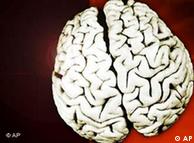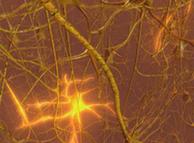French, American scientists find master switch for adult epilepsy

Temporal lobe epilepsy affects a small percentage of people
US and French researchers have made a discovery that may lead to new
ways of treating and preventing a severe form of epilepsy. They have
uncovered the switch that transforms healthy brain cells into epileptic
ones.
A team of French and American scientists have announced the
discovery of the so-called "master switch," the main gene that appears
to control temporal lobe epilepsy, a serious neurological condition that
causes recurring seizures.
Temporal lobe epilepsy, or TLE, is the most common form of epilepsy
in adults. The disease affects one to two percent of the world's
population. Among adult neurological conditions, only migraine headaches
are more prevalent.
The findings mean that someday, researchers may be able to flip off
that master switch, preventing healthy brain cells from turning into
epileptic ones at all.
Their results were published late last month in the journal Annals of Neurology.
The research that led to the discovery was done by two teams of
scientist, one at the University of Marseille, as well as Inserm, the
French national biomedical research agency, and another group of
scientists at the University of California, Irvine, in the United
States.
Understanding a dangerous mechanism
Currently, TLE is resistant to treatment in 30 percent of cases, according to Christophe Bernard, who led the French team.
"People aren't born with epilepsy in its most frequent form," Bernard
told Deutsche Welle. He explained that TLE occurs as a result of an
"initial insult" to the brain: some sort of trauma, like an accident,
ischemia, or a fever fit, which may have occurred as many as five
decades earlier.
 Seizures are caused by abnormal, excessive neural firings Seizures are caused by abnormal, excessive neural firings
"The rationale of the study was to understand: What converts a normal
to epileptic brain? Can we prevent or delay it by blocking it for
at-risk patients?" he asked.
TLE manifests after the "initial insult" causes major reorganization
of the molecules governing the behavior of neurons, the cells that
communicate within the brain. The researchers identified a gene in the
normal adult brain that Bernard called a "supercontroller."
'A dramatic change in understanding'
"It has the potential to control 1,800 other genes, and it modifies
most of these genes in epilepsy," he said. "This supergene is usually
switched off, but it is switched on by the initial insult."
In California, the research group led by Tallie Baram at the
University of California, Irvine, said in a statement that the discovery
"marks a dramatic change in our understanding of how TLE comes about."
Previously, it was believed that neurons died after one of these
initial damaging insults, and that the remaining neurons reorganized
with unusual connections
"However, in both people and model animals, epilepsy can arise
without the apparent death of brain cells," she added. "The neurons
simply seem to behave in a very abnormal way."
To learn why, the scientists focused on ion channels - molecules that
straddle the boundaries of brain cells and govern how they fire and
communicate among themselves. Specifically, they explored an ion channel
called c, which is suppressed in response to brain seizures,
injuries and infections that lead to epilepsy.
HCN1, DNA, and NRSF
They hoped to find the long-sought mechanism that triggers epileptic activity in previously normal brain cells.
This new study reveals that mechanism: the HCN1 channel gene and
about three dozen other important genes are altered by a major cellular
repressor - the aforementioned "supergene" - known as a
neuron-restrictive silencer factor, or NSRF. This increases after events
that give rise to epilepsy.
 The research team identified the genes responsible for this type of epilepsyNRSF
proteins work by attaching to the DNA of selected genes and shutting
them down, causing neurons to fire abnormally and promoting the
development of epilepsy. When NRSF was prevented from linking to HCN1
and other NRSF-regulated genes, the development of epilepsy was markedly
lessened. The research team identified the genes responsible for this type of epilepsyNRSF
proteins work by attaching to the DNA of selected genes and shutting
them down, causing neurons to fire abnormally and promoting the
development of epilepsy. When NRSF was prevented from linking to HCN1
and other NRSF-regulated genes, the development of epilepsy was markedly
lessened.
This "major breakthrough" was welcome after some 15 years of
research, University of Marseille's Bernard said. Now, the researchers
are examining the best ways to treat people who suffer one of these
"initial brain insults."
The task at hand is to figure out which people are most at-risk, and
to learn more about predictive biomarkers for the disease, Bernard said.
The aim is to figure out not only how to slow down the eventual onset
of epilepsy but to stop it altogether.
Call for funding
"Now it is just a question of money and getting funds to continue
this research," said Bernard. "We have the ideas and the concepts, but
if I really want to go for it, and see results quickly, we would need a
lot of money."
Baram at UC Irvine said her team is "quite excited" about the
discovery, which is a "crucial step" toward designing drugs to prevent
the disease.
"We don't want to just treat people with epilepsy," she said. "We
hope to develop medicines that will prevent epilepsy from occurring –
and influence the lives of millions of people around the globe."
Author: Jennifer Abramsohn
Editor: Cyrus Farivar
http://www.dw-world.de/dw/article/0,,15194670,00.html
| 








